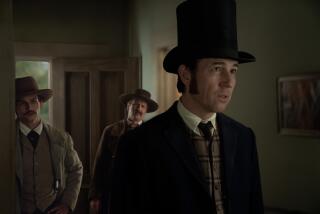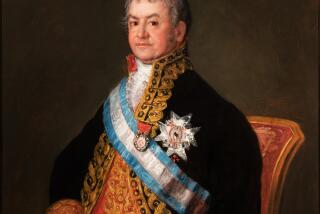The Man Behind the ‘Great Experiment’
- Share via
That whole thing about the cherry tree? Forget that. And the wooden teeth? Nonsense. The stuffy old guy pictured on the $1 bill? That’s hardly the real George Washington.
A slightly different image of America’s first president emerges from a new exhibit at the Huntington Library, Art Collections and Botanical Gardens. He was a strapping young man, an ambitious military officer, a natural but reluctant leader.
And--one small detail--he was a fabulous dancer.
Several exhibits will commemorate the 200th anniversary of Washington’s death in 1799, but the Huntington’s is regarded as the most ambitious. Titled “The Great Experiment: George Washington and the American Republic,” it is the largest collection of Washington-related documents ever assembled, and many of them have never before been on public display. In addition to the Huntington’s own manuscripts and paintings, materials have come from the Smithsonian, Mount Vernon, the Pierpont Morgan Library in New York and private collections.
The Washington who emerges is more flesh and blood than the almost mythological figure in history textbooks, said John Rhodehamel, who curated the exhibit and wrote the accompanying catalog. Washington is remembered as a military leader who became head of state, he said, yet his achievements as a statesman during the founding of the United States are overlooked.
“Adams, Madison, Jefferson were all there--and yet all of them looked to Washington for leadership,” said Rhodehamel, who is the Huntington’s curator of American history. “If he was a simple figurehead, I think one of these other men would have stepped forward himself.”
“The Great Experiment” begins with Washington as a young man of modest prospects. A timeline along the north wall of the gallery traces his life through five stages: the early years, the American Revolution, the framing of the Constitution, his presidency and his final years. Besides the handwritten letters, the show contains objects ranging from silver from Mount Vernon, his home in Virginia, to locks of Washington’s hair and one of his pistols. From March through May, “The Great Experiment” will be complemented by the traveling show “The Treasures of Mount Vernon.” Objects such as Washington’s cane and non-wooden dentures will be on display in the Virginia Steele Scott Gallery.
The exhibit’s title comes from Washington’s own words: “The establishment of our new Government seemed to be the last great experiment for promoting human happiness.”
Now, 222 years after the Declaration of Independence, it is difficult to comprehend the tremendous odds against the success of that experiment. In the war, America’s army of volunteer militiamen were routinely routed by the professional British soldiers.
Even after the war, said Gordon S. Wood, a professor of history at Brown University and a leading scholar on Washington, there was no assurance that the new republic would survive. “There were no great republics. The only ones were tiny little states in Italy or Holland. And here was this great continent attempting to become republican. Everyone predicted that, no, this can’t last, that it’s destined to fail.”
The fact that it didn’t fail is due, in great part, to Washington’s leadership. “Anybody that bothers to spend time with Washington is impressed with the immensity of his achievements,” Rhodehamel said. “But he’s not easy.” Indeed, Washington’s most important accomplishments are born not out of victory but out of heroic restraint.
Washington started out with unbridled personal ambition, as reflected in his published journal of an expedition from Virginia to Lake Erie. In his early 20s, he fought in the French and Indian War, distinguishing himself as a courageous leader. He was also incredibly lucky. Present at several bloody battles, including Gen. Braddock’s defeat at Ft. Duquesne, Washington escaped without injury.
His string of good fortune continued throughout the Revolutionary War. Bullets grazed his jacket, horses were shot out from underneath him, but Washington was never wounded.
Washington was not a great military strategist, Rhodehamel said, but what he did do was keep 13 colonies united in the fight against England. Equally difficult, he kept the Continental Army together for the eight long years of the war. In March of 1783, some officers--frustrated at being unpaid for years--threatened to overthrow Congress. Washington, with a 20-minute speech about liberty and sacrifice, single-handedly put down the brewing coup d’etat.
Still, after the Revolution was over, most expected Washington to demand some reward for his role. Instead, he simply retired to go back to private life.
“That was a monumental act. There was nothing like it in the history of the world,” Wood said. “Here was a victorious general who could have expected all sorts of political rewards for his conquests, and yet he turns in his sword.”
The move earned him such respect and such trust that he was the obvious choice to be the first head of the executive branch when the Constitution was adopted four years later. Similarly, after two terms in that office, he resigned, allaying the fear that Washington and future presidents would serve for life.
“You feel that this man couldn’t be real,” Wood said. “He doesn’t seem to have any faults of the ordinary sort. . . . He was quick to anger. He controlled immense passions. His whole life is a story of self-control.”
There are, of course, no photographs of Washington. To visualize him, there are only portrait paintings as guides--and the most famous of those is somewhat misleading. Gilbert Stuart’s 1797 painting--on which the $1 bill etching is based--was completed only a few years before Washington’s death. The painting, which is part of the exhibit, shows a Washington who was about 65--quite old for the time. He’d lost his teeth and had dentures that pushed his lower lip out awkwardly--a flaw that was glossed over on the dollar bill. He was at the end of his second trying term as president.
A slightly better physical representation is presented by Charles Willson Peale, who painted Washington during the Revolution. In full uniform, Washington leans against the barrel of a cannon, hand on hip.
Peale’s is not, unfortunately, a great painting, according to Rhodehamel, though it does give a better sense of Washington’s presence. Closer still is a bust by French sculptor Jean-Antoine Houdon done in 1787. Washington was 53, at the height of his fame and popularity. At the Huntington, the bust rests on a pedestal at a height of exactly 6 feet, 3 inches, Washington’s actual height.
Washington’s eight years as president made his Revolutionary War years look like a holiday. He headed off to his inauguration with a sense of dread. In a letter to American Gen. Henry Knox that is on display, he said he had “feelings not unlike those of a culprit who is going to the place of his execution.”
It was, in fact, nearly that bad. As the new government groaned into action, political parties began to take hold. Washington came under vicious political attack and was accused of wanting to be king. A schism between Alexander Hamilton, secretary of the treasury, and Thomas Jefferson, secretary of state, threatened to tear the administration apart and made the citizenry naturally anxious.
“People didn’t understand that you could oppose the administration without being an enemy of the country,” Rhodehamel said. “People were frightened that they would get a monarch. . . . In some ways, these fears were reasonable.”
Washington retired to Mount Vernon in 1797 and spent his remaining years trying to get his plantation in order. He also wrote a will that, in addition to providing for his wife and stepchildren, freed 125 African American slaves at Mount Vernon.
The nation, however, didn’t stabilize in his absence and he was asked in 1799 to come out of retirement yet again. In a letter to Connecticut Gov. Jonathan Trumbull Jr., which is also on display, Washington shows complete disillusionment with the viscous partisanship that had taken hold of the government.
“He may have died a bit unhappy,” Rhodehamel said. “I don’t know if he really knew whether the United States would endure.”
As for that bit about cutting down the cherry tree, that was invented after Washington’s death by Mason Locke Weems, who wrote a popular biography of Washington that was laced with moral fables. Weems’ accuracy may have been questionable, Wood said, but his choice of character was good.
Wood suggests that in seeking governmental leadership from military generals--from Andrew Jackson to Colin Powell--Americans are looking for another Washington, someone who transcends partisan bickering.
“I think that Washington, the man, still is the model of what an ideal president ought to be,” Wood said. “It’s impossible to have that person. We have political parties now. And it’s a democratic world. But Washington lingers on as a model of what we’d like our leaders to be.”
BE THERE
“The Great Experiment: George Washington and the American Republic” at the Huntington Library, Art Collections and Botanical Gardens, 1151 Oxford Road, San Marino. Tuesdays-Fridays, noon-4:30 p.m.; Saturdays and Sundays, 10:30 a.m.-4:30 p.m. Closes May 30. $8.50, $7 seniors, $5 students, free for children under 12. (626) 405-2141.
More to Read
The biggest entertainment stories
Get our big stories about Hollywood, film, television, music, arts, culture and more right in your inbox as soon as they publish.
You may occasionally receive promotional content from the Los Angeles Times.










